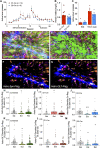Plasticity in astrocyte subpopulations regulates heroin relapse
- PMID: 35947652
- PMCID: PMC9365285
- DOI: 10.1126/sciadv.abo7044
Plasticity in astrocyte subpopulations regulates heroin relapse
Abstract
Opioid use disorder (OUD) produces detrimental personal and societal consequences. Astrocytes are a major cell group in the brain that receives little attention in mediating OUD. We determined how astrocytes and the astroglial glutamate transporter, GLT-1, in the nucleus accumbens core adapt and contribute to heroin seeking in rats. Seeking heroin, but not sucrose, produced two transient forms of plasticity in different astroglial subpopulations. Increased morphological proximity to synapses occurred in one subpopulation and increased extrasynaptic GLT-1 expression in another. Augmented synapse proximity by astroglia occurred selectively at D2-dopamine receptor-expressing dendrites, while changes in GLT-1 were not neuron subtype specific. mRNA-targeted antisense inhibition of either morphological or GLT-1 plasticity promoted cue-induced heroin seeking. Thus, we show that heroin cues induce two distinct forms of transient plasticity in separate astroglial subpopulations that dampen heroin relapse.
Figures






Similar articles
-
Heroin Cue-Evoked Astrocytic Structural Plasticity at Nucleus Accumbens Synapses Inhibits Heroin Seeking.Biol Psychiatry. 2019 Dec 1;86(11):811-819. doi: 10.1016/j.biopsych.2019.06.026. Epub 2019 Jul 8. Biol Psychiatry. 2019. PMID: 31495448 Free PMC article.
-
Heroin Seeking and Extinction From Seeking Activate Matrix Metalloproteinases at Synapses on Distinct Subpopulations of Accumbens Cells.Biol Psychiatry. 2021 May 15;89(10):947-958. doi: 10.1016/j.biopsych.2020.12.004. Epub 2020 Dec 9. Biol Psychiatry. 2021. PMID: 33579535 Free PMC article.
-
Astrocytes in the ventral pallidum extinguish heroin seeking through GAT-3 upregulation and morphological plasticity at D1-MSN terminals.Mol Psychiatry. 2022 Feb;27(2):855-864. doi: 10.1038/s41380-021-01333-5. Epub 2021 Oct 12. Mol Psychiatry. 2022. PMID: 34642457 Free PMC article.
-
Astrocytes as cellular mediators of cue reactivity in addiction.Curr Opin Pharmacol. 2021 Feb;56:1-6. doi: 10.1016/j.coph.2020.07.009. Epub 2020 Aug 27. Curr Opin Pharmacol. 2021. PMID: 32862045 Free PMC article. Review.
-
Dose titration with the glucagon-like peptide-1 agonist, liraglutide, reduces cue- and drug-induced heroin seeking in high drug-taking rats.Brain Res Bull. 2022 Oct 15;189:163-173. doi: 10.1016/j.brainresbull.2022.08.022. Epub 2022 Aug 28. Brain Res Bull. 2022. PMID: 36038016 Free PMC article. Review.
Cited by
-
Enhancing translation: A need to leverage complex preclinical models of addictive drugs to accelerate substance use treatment options.Pharmacol Biochem Behav. 2024 Oct;243:173836. doi: 10.1016/j.pbb.2024.173836. Epub 2024 Jul 26. Pharmacol Biochem Behav. 2024. PMID: 39067531 Review.
-
Astrocyte morphological remodeling regulates consciousness state transitions induced by inhaled general anesthesia.Mol Psychiatry. 2025 Sep;30(9):4006-4022. doi: 10.1038/s41380-025-02978-2. Epub 2025 Apr 1. Mol Psychiatry. 2025. PMID: 40169801
-
Neuroimmune Mechanisms of Opioid Use Disorder and Recovery: Translatability to Human Studies, and Future Research Directions.Neuroscience. 2023 Sep 15;528:102-116. doi: 10.1016/j.neuroscience.2023.07.031. Epub 2023 Aug 9. Neuroscience. 2023. PMID: 37562536 Free PMC article. Review.
-
Impaired extinction of cocaine seeking in HIV-infected mice is accompanied by peripheral and central immune dysregulation.Res Sq [Preprint]. 2023 Sep 28:rs.3.rs-3276379. doi: 10.21203/rs.3.rs-3276379/v1. Res Sq. 2023. Update in: Commun Biol. 2024 Mar 30;7(1):387. doi: 10.1038/s42003-024-06079-8. PMID: 37841842 Free PMC article. Updated. Preprint.
-
Neuron-astrocyte omnidirectional signaling in neurological health and disease.Front Mol Neurosci. 2023 Jun 8;16:1169320. doi: 10.3389/fnmol.2023.1169320. eCollection 2023. Front Mol Neurosci. 2023. PMID: 37363320 Free PMC article. Review.
References
-
- Kalivas P. W., The glutamate homeostasis hypothesis of addiction. Nat. Rev. Neurosci. 10, 561–572 (2009). - PubMed
-
- Danbolt N. C., Glutamate uptake. Prog. Neurobiol. 65, 1–105 (2001). - PubMed
-
- Scofield M. D., Li H., Siemsen B. M., Healey K. L., Tran P. K., Woronoff N., Boger H. A., Kalivas P. W., Reissner K. J., Cocaine self-administration and extinction leads to reduced glial fibrillary acidic protein expression and morphometric features of astrocytes in the nucleus accumbens core. Biol. Psychiatry 80, 207–215 (2016). - PMC - PubMed
Grants and funding
LinkOut - more resources
Full Text Sources

